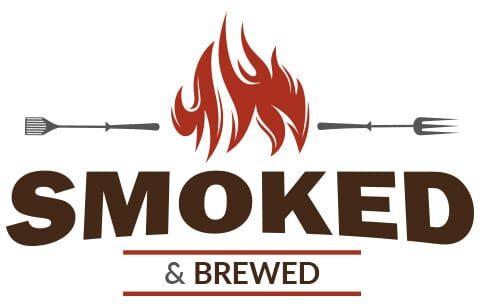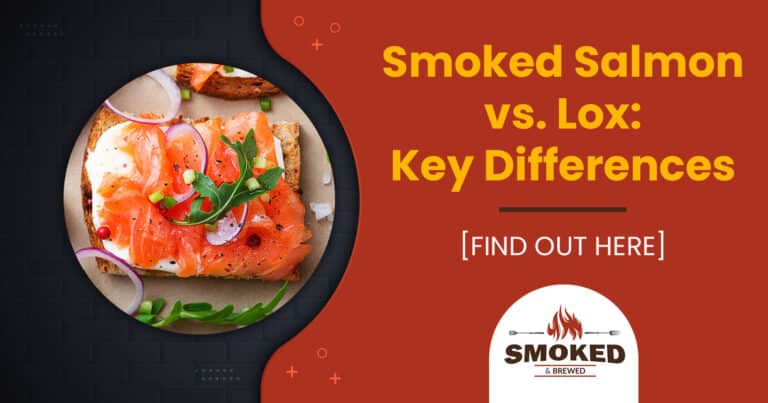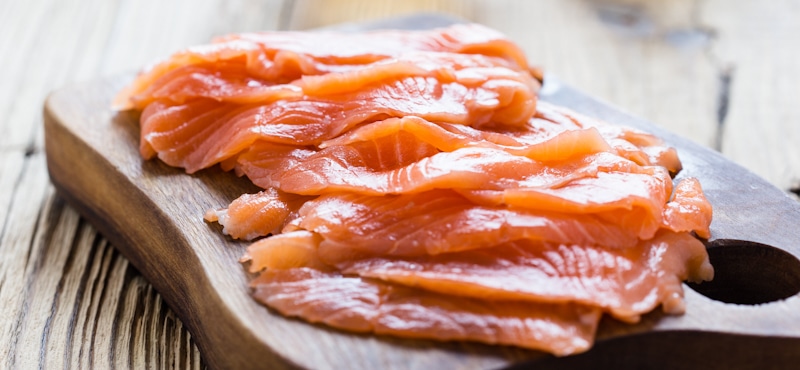Salmon is an acquired taste, but with said taste being rapidly acquired, salmon farming and products have started becoming more popular by the day. One result of an increase in novice interest is confusion. If you’re wondering why Lox and Smoked Salmon are separate terms when the products look the same, you’ve come to the right place.
Smoked Salmon is salt-cured and brined for a few days before being smoked and presented. On the other hand, Lox refers to a cut of salmon belly that has been salt-cured for an extended period, usually two and a half months. This creates differences in their taste and price.
In this article, we will dive deeper into the key differences between Lox and Samoked Salmon, including how the two vary in:
- the type of cut
- the price per pound
- the taste and smell
- serving and variations
- class adoption
- nutritional value

The Cut
Nowadays, any salt-cured cut of Salmon that isn’t smoked is referred to as Lox, but authentic Lox is made from the fatty belly of Salmon. In contrast, smoked Salmon is cut along the full length of the fish. The difference between the cut of Salmon used for Lox and the one used for smoking leads to further differences in taste, texture, and macronutrients. These differences are minimized when the Lox in question isn’t made from the fatty belly and is simply smoked Salmon minus the “smoked” part.
To get authentic Lox, you must purchase from a fishing spot-adjacent market or a small-to-medium business that specializes in Salmon products. These are located near salmon farms. Most “high-end” Lox products omit the fatty belly constraint and go straight to using an entire cut of Salmon. This brings us to the second difference.
Cuisine Class
When it comes to cuisine class, Lox is the equivalent of spam among salmon products. It uses one of the cheapest cuts of fish and is preserved in a way that is practically outdated. An invention of the past without refrigerators, Lox is in many ways redundant and unnecessary in contemporary seafood.
On the other hand, smoked Salmon is like low-effort sushi, sitting appropriately, a few rungs below it in the social approval hierarchy of marine delicacies. Smoked Salmon is used as an appetizer in many establishments that have won Michelin stars.
Lox is served over a layer of cream cheese housed atop a bagel or bun at delis serving a breakfast crowd. It is a firmly middle-class delicacy, while smoked Salmon has become an acquired taste of the upper-income class.
Preparation Time
Again, the authenticity of the term Lox matters when we discuss the difference in preparation time between smoked Salmon and Lox. It takes three months to properly salt-cure Lox while smoked Salmon is cured in 1 to 3 days, then brined and smoked.
The fact that multiple preserving techniques are applied to Salmon means it will be quicker to prepare compared to Lox which has to sit in salt till it is truly preserved enough not to require refrigeration.
Taste
Since the cut and the preservation method of Lox is different than that of smoked Salmon, one can infer that the difference would be reflected in their taste. Lox has no smoky aftertaste because it is never smoked. It is much saltier, though, because it stays up to 40 times longer in a salt solution.
Smoked Salmon has a smoky taste because it is the last step of its preparation method. It also features a hint of sweetness and foreign flavor because of brining. As you may know, brining is a process of marinating with a focus on juiciness. Because smoked Salmon is brined, it contains more flavor and water, which contributes to the next difference.
Texture
Surprisingly, the difference in the texture of Lox and smoked Salmon is not very significant. While the curing process lasts longer for Lox drying it out more, it is also made from a cut that contains more water. Moreover, Lox isn’t smoked, so it side-steps the dehydration that occurs at that stage of preservation.
Smoked Salmon is brined, which adds to its liquid content, yet the smoking process offsets the juiciness of the final product. Side by side, it is almost impossible to tell smoked Salmon apart from Lox if you’re going by texture alone. However, the smell of the two is far from the same, but that’s a separate subtopic.
Smell
Lox and smoked salmon smell different to the educated nose. Lox, despite being cured longer, has an oceanic smell, while smoked Salmon is olfactory-neutral. Yes, Salmon does have an aroma, but it’s virtually non-existent compared to that of Lox. The salt used to cure Salmon when preparing Lox brings out the aromatic elements of the meat. Moreover, salt itself has marine connotations because we often associate salt with the sea.
That’s why the former is preferred by fine dining establishments while the latter is championed by delis. Regardless of whether you like Delis or not, you will probably agree that they aren’t the best place for those with sensitive noses. Deli meats, including Lox, do not have a place in an upscale restaurant, which brings us to the price factor.
Price
While you will not often find Lox in an upscale restaurant, it is far from cheap fish pickle it might come off as when you read its description. The delis and bagel stalls that sell Lox and items featuring Lox can charge quite a premium in New York City. But Smoked Salmon can be further overpriced there.
In a demand-controlled environment with even supply, Lox would be less expensive than smoked Salmon, but since multiple factors affect the price of these products, Lox costs only $10 less than smoked Salmon per pound. That said, the price of these items at dining destinations can further vary because of the establishments’ pricing policies, marketing, and audience.
Serving
As covered earlier, Lox is a deli and bagel-stall favorite, while smoked Salmon is often positioned as an appetizer. Here’s how their serving and presentation vary. Since Lox has a salty aroma, it is paired with cheese which makes the protein odor-neutral. The cheese sits atop a bakery item which is usually a bagel but can be a pretzel bread, bun, or dinner roll as well. On the other hand, smoked Salmon is often presented as the base for bite-sized fancy snacks.
One presentation involves rolling up salad into fine-cut Salmon. In some presentations, small pieces of smoked Salmon are placed on top of cucumber slices. Salmon can be cut very thin, thinner than most proteins, which is why, in most cases, the chef leverages the thinner cuts of Salmon to make a snack that is interesting to look at.
Variations
Lox and Smoked Salmon also differ because while Lox is usually the same everywhere you go, smoked Salmon can be significantly different depending on whether it was cold smoked or hot smoked. When hot smoked, the Salmon is kept in a smoker at 70 degrees Fahrenheit for well over 12 hours.
This is the smoked salmon variety that is not distinguishable in texture from Lox. There’s also the possibility that the smoked Salmon in question is hot smoked. This is the “well-done steak” equivalent of smoked fish. Hot smoked Salmon is smoked at more than double the temperature of cold-smoked Salmon. The cut is kept in the 145 degrees Fahrenheit smoker for 8 hours and becomes thicker and darker. It looks over-cooked but is technically smoked.
When it comes to preparing Lox, there are no variations that can produce such a difference in the appearance of the final product. But as mentioned earlier in this post, some of the “lox” in the market isn’t exclusive to the salmon belly. Random cuts of Salmon are salt-cured for an extended period and are labeled Lox. That can be considered a variation as well but isn’t accurate to the definition of Lox.
Macros And Minerals
If we stay true to the definition of Lox, we essentially compare a cross-cut of Salmon with the fatty belly of the same fish. Of course, the macros of the two would vary. In diet and nutrition, macros refer to the macro-nutrients, mainly protein, carbohydrates, and fats.
A standard serving of Lox contains 6% fat, 7% protein, and 0% carbs. The carbs in a lox dish come from the bakery item used as the base. What’s concerning about Lox is that despite having few calories per serving, it has 71% sodium and 7% cholesterol. Smoked Salmon has 6% fat but 36% protein, making it the healthier choice. It still contains significant sodium at 32%, but it is a lot less than the amount found in Lox.
Final Thoughts
Now that you know how different Smoked Salmon and Lox are despite coming from the same fish, it’s time to think about which type of salmon serving is right for you. For a one-off breakfast item or even a midday snack, feel free to go for Lox but to avoid the risks of a high-salt diet, don’t make Lox a staple of your daily routine. Opt for the healthier smoked salmon option.
Also read: Baby Back Vs Spare Ribs: What’s The Difference? [ANSWERED]
Scot has loved smoking food in his free time for the last few years. Each major holiday or off-weekend, Scot spends days testing and prepping new recipes for perfection.


